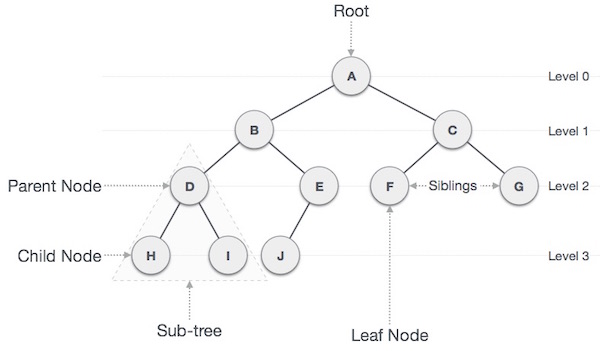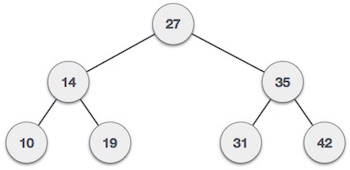- 数组与链表
- 堆栈和队列
- 搜索算法
- 排序算法
- 图形结构
- 树结构
- 递归教程

树表示通过边连接的节点,我们将专门讨论二叉树或二叉搜索树。
二叉树是用于数据存储目的的特殊数据结构,二叉树有一个特殊条件,即每个节点最多可以有两个孩子,二叉树既有序数组又有链表的好处,因为搜索与排序数组一样快,插入或删除操作也与链表一样快。

以下是关于树的重要术语。
Path - 路径是指沿树边缘的节点序列。
Root - 树顶部的节点称为根,每棵树只有一个根,并且有一个从根节点到任何节点的路径。
Parent - 除根节点外,任何节点的上边缘都指向称为父级的节点。
Child - 在给定节点下方通过其向下边缘连接的节点称为其子节点。
Leaf - 没有任何子节点的节点称为叶子节点。
Subtree - 子树表示节点的后代。
Visiting - 访问是指在控件位于节点上时检查节点的值。
Traversing - 遍历是指以特定顺序通过节点。
Levels - 节点的级别表示节点的生成,如果根节点处于级别0,则其下一个子节点处于级别1,其子代处于级别2,依此类推。
Keys - key表示节点的值,基于该值将对节点执行搜索操作。
二分搜索树
二分搜索树表现出特殊的行为。节点的左子节点的值必须小于其父节点的值,并且节点的右子节点的值必须大于其父节点的值。

我们将使用节点对象来实现树,并通过引用将它们连接起来。
树节点
编写树节点的代码与下面给出的代码相似。它有一个数据部分,并引用了它的左右子节点。
struct node { int data; struct node *leftChild; struct node *rightChild; }
BST基本操作
可以对二分搜索树数据结构执行的基本操作如下:
插入 - 在树中插入元素/创建树。
搜索 - 搜索树中的元素。
预定遍历 - 以预定顺序遍历一棵树。
有序遍历 - 以有序方式遍历树。
后序遍历 - 以后序方式遍历树。
在本章中,我们将学习创建(插入)树结构并在树中搜索数据项,在下一章中,我们将学习树遍历方法。
插入操作
第一次插入将创建树,之后,无论何时要插入元素,都首先要找到其正确位置,从根节点开始搜索,然后如果数据小于键值,则在左侧子树中搜索空位置并插入数据。否则,在右侧子树中搜索空白位置并插入数据。
If root is NULL then create root node return If root exists then compare the data with node.data while until insertion position is located If data is greater than node.data goto right subtree else goto left subtree endwhile insert data end If
插入函数的实现应如下所示-
void insert(int data) { struct node *tempNode = (struct node*) malloc(sizeof(struct node)); struct node *current; struct node *parent; tempNode->data = data; tempNode->leftChild = NULL; tempNode->rightChild = NULL; //if tree is empty, create root node if(root == NULL) { root = tempNode; } else { current = root; parent = NULL; while(1) { parent = current; //go to left of the tree if(data < parent->data) { current = current->leftChild; //insert to the left if(current == NULL) { parent->leftChild = tempNode; return; } } //go to right of the tree else { current = current->rightChild; //insert to the right if(current == NULL) { parent->rightChild = tempNode; return; } } } } }
搜索操作
每当要搜索元素时,都从根节点开始搜索,然后如果数据小于键值,则在左侧子树中搜索该元素。否则在右子树中搜索该元素。
链接:https://www.learnfk.comhttps://www.learnfk.com/data-structures-algorithms/tree-data-structure.html
来源:LearnFk无涯教程网
If root.data is equal to search.data return root else while data not found If data is greater than node.data goto right subtree else goto left subtree If data found return node endwhile return data not found end if
该算法的实现应如下所示。
struct node* search(int data) { struct node *current = root; printf("Visiting elements: "); while(current->data != data) { if(current != NULL) printf("%d ",current->data); //go to left tree if(current->data > data) { current = current->leftChild; } //else go to right tree else { current = current->rightChild; } //not found if(current == NULL) { return NULL; } return current; } }
C实现二分搜索
#include <stdio.h> #include <stdlib.h> struct node { int data; struct node *leftChild; struct node *rightChild; }; struct node *root = NULL; void insert(int data) { struct node *tempNode = (struct node*) malloc(sizeof(struct node)); struct node *current; struct node *parent; tempNode->data = data; tempNode->leftChild = NULL; tempNode->rightChild = NULL; //if tree is empty if(root == NULL) { root = tempNode; } else { current = root; parent = NULL; while(1) { parent = current; //go to left of the tree if(data < parent->data) { current = current->leftChild; //insert to the left if(current == NULL) { parent->leftChild = tempNode; return; } } //go to right of the tree else { current = current->rightChild; //insert to the right if(current == NULL) { parent->rightChild = tempNode; return; } } } } } struct node* search(int data) { struct node *current = root; printf("Visiting elements: "); while(current->data != data) { if(current != NULL) printf("%d ",current->data); //go to left tree if(current->data > data) { current = current->leftChild; } //else go to right tree else { current = current->rightChild; } //not found if(current == NULL) { return NULL; } } return current; } void pre_order_traversal(struct node* root) { if(root != NULL) { printf("%d ",root->data); pre_order_traversal(root->leftChild); pre_order_traversal(root->rightChild); } } void inorder_traversal(struct node* root) { if(root != NULL) { inorder_traversal(root->leftChild); printf("%d ",root->data); inorder_traversal(root->rightChild); } } void post_order_traversal(struct node* root) { if(root != NULL) { post_order_traversal(root->leftChild); post_order_traversal(root->rightChild); printf("%d ", root->data); } } int main() { int i; int array[7] = { 27, 14, 35, 10, 19, 31, 42 }; for(i = 0; i < 7; i++) insert(array[i]); i = 31; struct node * temp = search(i); if(temp != NULL) { printf("[%d] Element found.", temp->data); printf("\n"); }else { printf("[ x ] Element not found (%d).\n", i); } i = 15; temp = search(i); if(temp != NULL) { printf("[%d] Element found.", temp->data); printf("\n"); }else { printf("[ x ] Element not found (%d).\n", i); } printf("\nPreorder traversal: "); pre_order_traversal(root); printf("\nInorder traversal: "); inorder_traversal(root); printf("\nPost order traversal: "); post_order_traversal(root); return 0; }
Visiting elements: 27 35 [31] Element found. Visiting elements: 27 14 19 [ x ] Element not found (15). Preorder traversal: 27 14 10 19 35 31 42 Inorder traversal: 10 14 19 27 31 35 42 Post order traversal: 10 19 14 31 42 35 27
祝学习愉快!(内容编辑有误?请选中要编辑内容 -> 右键 -> 修改 -> 提交!)
 《数据结构和算法入门教程》
《数据结构和算法入门教程》 